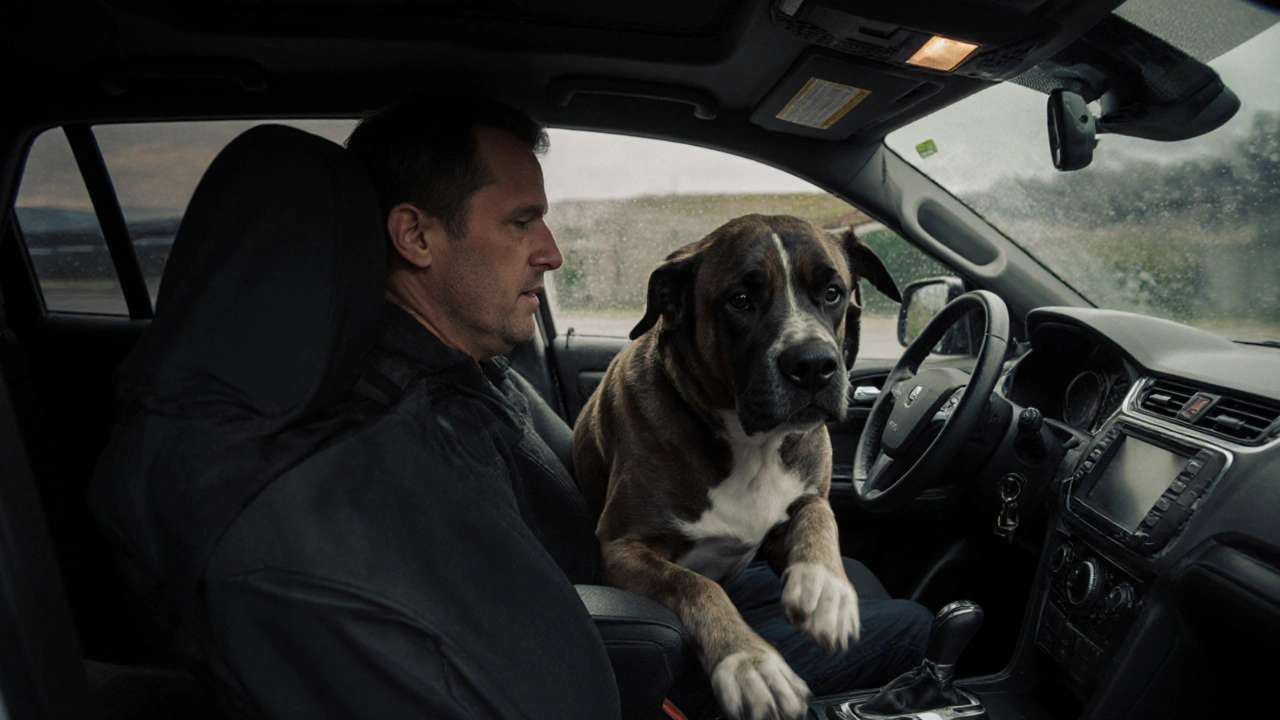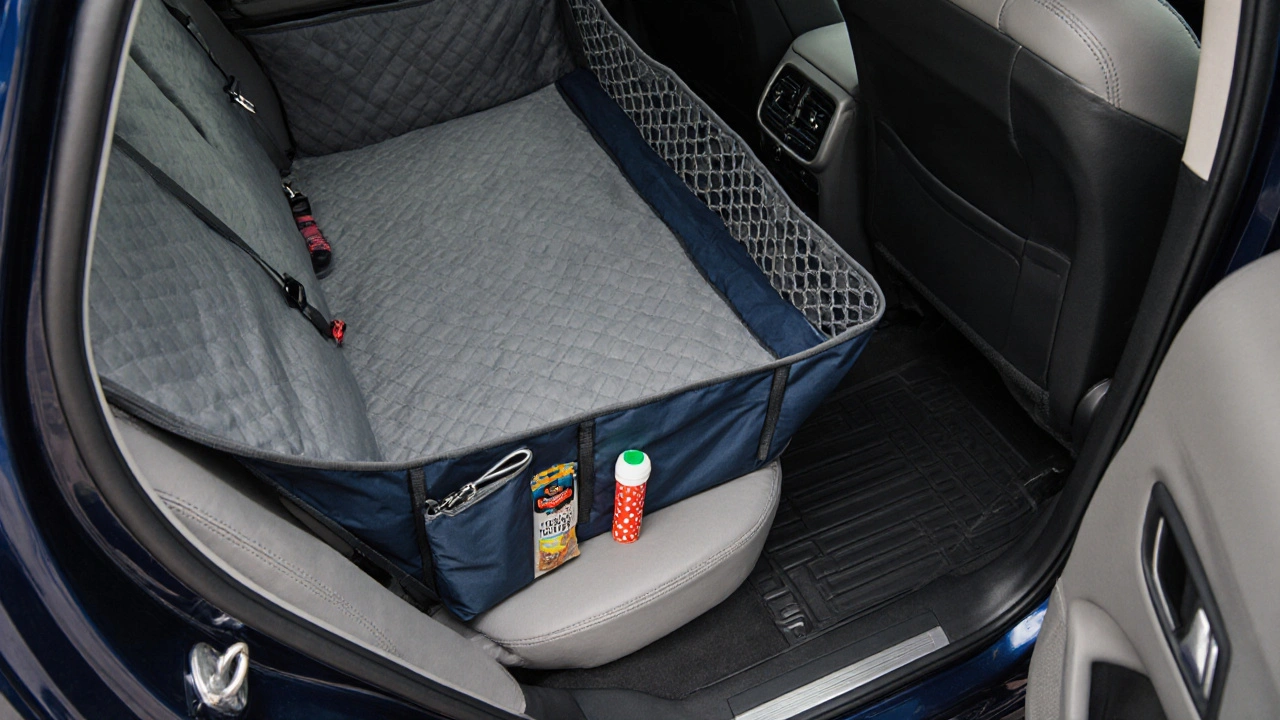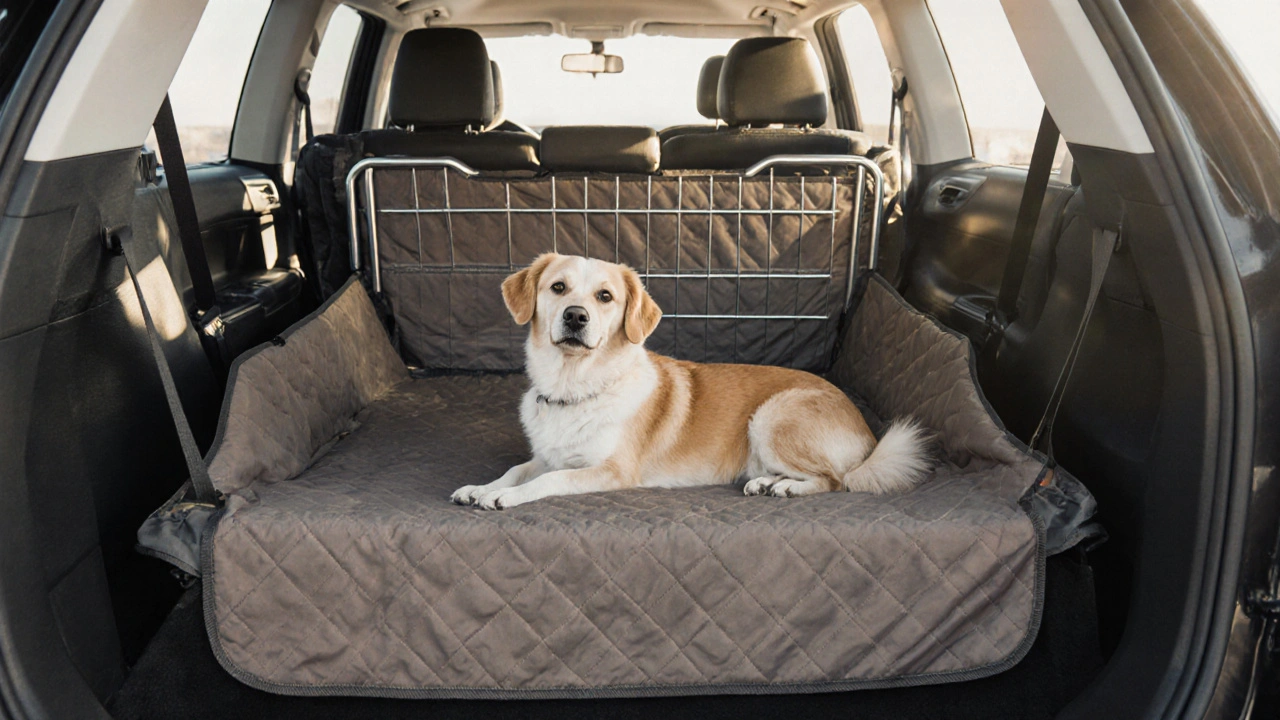Every pet owner knows the struggle: muddy paws on leather seats, fur clinging to everything, or worse - your dog jumping into the front seat while you’re driving. It’s not just messy. It’s dangerous. And it doesn’t have to be that way. Pet seat covers and barriers aren’t just convenient - they’re essential for keeping your car clean, your pet safe, and your sanity intact.
Why Pet Seat Covers Matter More Than You Think
Most people think a seat cover is just a layer of fabric to protect against dirt. But modern pet seat covers do far more. They’re built with waterproof linings, non-slip bottoms, and reinforced stitching to handle claws, shaking, and long drives. A good cover doesn’t just catch hair - it stops moisture, mud, and even accidents from ever reaching your car’s upholstery.
Take the 2023 survey by the American Pet Products Association: 67% of dog owners travel with their pets at least once a month. That’s over 40 million households in the U.S. alone. And 82% of them said their car’s interior showed visible wear within six months of regular pet travel. The average cost to professionally clean pet stains from a sedan? Around $180. A quality seat cover? Under $60.
Not all covers are created equal. Look for ones made from 600D polyester or Oxford fabric - they’re tough enough to resist tearing. Avoid thin, flimsy materials that bunch up or slide around. The best ones have built-in headrest straps, seatbelt slots, and a rear flap that tucks under the seat to seal out debris. Brands like Kurgo, PetSafe, and Solvit have been tested by independent labs to withstand over 10,000 abrasion cycles - that’s years of use.
How Pet Barriers Keep Everyone Safe
A seat cover protects your seats. A barrier protects your life.
When a dog moves freely in the car, it’s not just a distraction - it’s a hazard. In a sudden stop or crash, an unrestrained pet becomes a projectile. The Center for Pet Safety tested this in 2024. A 50-pound dog in a moving vehicle at 30 mph became a force of nearly 1,500 pounds in a collision. That’s enough to break a windshield or crush a front-seat passenger.
That’s why pet barriers - metal or mesh panels that fit between the back and front seats - are non-negotiable. They’re not just for large dogs. Even small breeds can scramble into the front and interfere with steering or airbag deployment. A barrier keeps your pet contained in the back, where they’re safest and least likely to distract you.
Look for barriers with a secure mounting system. The best ones clamp onto seat headrests and use tension rods to lock in place without drilling or permanent modifications. Some even come with built-in doors so you can reach your pet without removing the barrier. Brands like Gruv and Midwest Homes offer crash-tested models that meet ASTM F2088 standards for pet restraints.
Combining Covers and Barriers for Maximum Protection
The real win comes when you use both together. A seat cover alone won’t stop a dog from jumping over the front seat. A barrier alone won’t stop wet paws from soaking into the seat cushion. Together, they create a full system of protection.
Here’s how to set it up right:
- Install the barrier first - make sure it’s tight and doesn’t wobble.
- Place the seat cover over the rear seats, tucking the edges under the seat base.
- Secure all straps and clips. Test by pulling on the cover - it shouldn’t shift.
- Use a cargo liner or mat behind the barrier to catch dirt from paws before they reach the seats.
This setup works for SUVs, hatchbacks, and even pickup trucks. For larger vehicles, consider a full-back seat cover that extends to the rear cargo area. Some even include built-in storage pockets for leashes, treats, and waste bags.

What to Avoid When Buying Pet Travel Gear
Not every product labeled “pet-friendly” is safe or durable. Here are the top three mistakes people make:
- Buying cheap mesh covers - They tear easily, and the mesh can snag on your pet’s claws. Look for solid fabric with reinforced seams.
- Using hammock-style covers without barriers - These leave gaps on the sides. Dogs can slip through and end up in the front seat or under pedals.
- Choosing barriers that don’t fit your car model - Universal fits often wobble. Check manufacturer specs. Many brands offer model-specific kits for Honda CR-Vs, Ford Explorers, and Toyota RAV4s.
Also skip anything with plastic buckles or cheap zippers. Metal hardware lasts longer and holds up better under stress. And never buy a barrier that requires drilling into your car’s frame. It voids warranties and can damage your vehicle’s structure.
Real-Life Scenarios: How These Products Save the Day
One mother in Bristol, UK, told me her 8-year-old Labrador used to track mud and sand into her VW Golf every weekend. After installing a Kurgo Backseat Guardian barrier and a waterproof seat cover, she went from cleaning the car every week to once every two months. “I didn’t realize how much I was dreading road trips until I stopped worrying about the mess,” she said.
Another user, a vet tech who transports rescue dogs, said she used to replace car seat covers every three months. After switching to a heavy-duty Solvit barrier and a 600D polyester cover, she’s had the same setup for two years. “I’ve had dogs vomit, pee, and shake wet fur all over it. It wipes clean in seconds,” she said.
And then there’s the safety angle. A dad in Texas shared how his 120-pound Great Dane lunged forward during a sudden brake. Without a barrier, he would’ve been thrown into the dashboard. With one, the dog stayed put. “I didn’t even know the barrier was there until I saw it in the rearview,” he said. “Then I realized - it saved me.”

Easy Maintenance Tips to Keep Your Gear Working
Even the best gear needs care. Here’s how to keep it clean and functional:
- Shake out loose hair after every trip. Use a rubber glove or lint roller to grab stubborn fur.
- Wipe down the cover with a damp cloth and mild soap. Avoid bleach or strong chemicals - they break down waterproof coatings.
- For odors, sprinkle baking soda, let it sit for 15 minutes, then vacuum.
- Check barrier clasps and tension rods monthly. Tighten if they feel loose.
- Store covers rolled up, not folded, to prevent creases that can lead to tearing.
Most high-quality covers are machine washable. Check the label, but many can go in the washer on cold with a gentle cycle. Air dry - never use a dryer. Heat can melt waterproof layers.
Final Thought: It’s Not a Luxury - It’s a Necessity
Some people think pet seat covers and barriers are for “overly cautious” owners. But think about it: you buckle your seatbelt. You install child car seats. You don’t let your kids ride loose in the back. Why treat your pet any differently?
Pets are family. And family deserves to travel safely - without turning your car into a mess. The cost of a good cover and barrier is less than one professional cleaning. The peace of mind? Priceless.
Whether you’re heading to the park, the vet, or a weekend road trip - don’t wait until the damage is done. Equip your car now. Your seats, your safety, and your dog will thank you.
Can I use a pet seat cover without a barrier?
Yes, you can use a seat cover alone to protect your seats from hair and dirt. But without a barrier, your pet can still move into the front seat, which is dangerous while driving. A cover protects your car. A barrier protects your life - and your pet’s. For full safety, use both.
Do pet barriers fit all car models?
Not all barriers are universal. Some are designed for specific makes and models, like the Honda CR-V or Ford Explorer. Others use adjustable tension rods and fit most sedans and SUVs. Always check the product’s compatibility list before buying. If your car isn’t listed, look for a model with a wide fit range and read reviews from owners with similar vehicles.
Are pet seat covers machine washable?
Most high-quality pet seat covers are machine washable. Look for covers made from 600D polyester or Oxford fabric - they’re built to handle washing. Use cold water and a gentle cycle. Avoid bleach and fabric softeners. Always air dry - heat from dryers can damage waterproof linings and cause seams to weaken.
What’s the difference between a pet barrier and a pet gate?
A pet barrier is designed specifically for cars and attaches securely to the backseat headrests or seat frames to prevent pets from moving into the front. A pet gate is meant for homes - it stands on the floor and isn’t safe or stable in a moving vehicle. Never use a home pet gate in your car. It won’t hold in a crash and could become a dangerous projectile.
How do I know if a pet barrier is crash-tested?
Look for certifications like ASTM F2088 or those from the Center for Pet Safety. Brands like Gruv, Midwest Homes, and Sleepypod list crash-test results on their websites. If a product doesn’t mention testing, assume it’s not designed for safety. In a crash, untested barriers can break or shift - putting your pet and passengers at risk.
Can I use a pet seat cover in the front seat?
No. Front seat covers are not recommended and can interfere with airbag deployment, seatbelt sensors, and controls. Always keep pets in the back seat with a proper barrier. If your pet must ride in the front (e.g., small dog in a carrier), use a pet seat belt harness - never a seat cover meant for the back.


Comments
Teja kumar Baliga
My lab loves road trips and this post nailed it. Got a Solvit cover and barrier last year - no more fur on the seats, and I actually sleep during drives now. Simple, cheap, life-changing.
November 4, 2025 at 09:45
Tiffany Ho
I never thought about barriers being safety gear not just convenience. This makes so much sense now. Thanks for sharing.
November 6, 2025 at 04:52
Nicholas Zeitler
YES. YES. YES. Stop buying flimsy mesh covers. They’re a joke. 600D polyester or bust. And ALWAYS use a barrier. Your dog isn’t a pillow. It’s a living creature that needs protection too.
November 7, 2025 at 00:49
Kelley Nelson
One must acknowledge, with the utmost gravitas, that the anthropomorphic projection of familial status upon non-human animals, while emotionally gratifying, does not inherently confer upon them the same legal or physical entitlements as human passengers. One might, however, concede that the preservation of automotive upholstery constitutes a legitimate aesthetic imperative.
November 8, 2025 at 04:53
lucia burton
Let me break this down for you in terms of biomechanical risk mitigation and material science integrity. When you introduce a 50-pound mass into a 30mph kinetic system without restraint, you’re essentially creating a human-scale projectile with a momentum vector that exceeds 1,470 newtons of force upon deceleration - that’s not a ‘distraction,’ that’s a Class 3 impact hazard. And let’s not even get into the degradation of waterproof polymer coatings under UV exposure and chlorinated cleaning agents. You need a 600D Oxford weave with polyurethane lamination, bonded with double-stitched ballistic thread, and secured via tension-clamp mounting hardware calibrated to ANSI Z359.1 standards. Anything less is negligent.
November 10, 2025 at 02:38
k arnold
Wow. So you’re telling me I need to spend $120 so my dog doesn’t get to sit in the back like a normal dog? What’s next? A seatbelt for the cat?
November 11, 2025 at 11:52
Gareth Hobbs
They say 'crash-tested'... but who's testing it? The same companies that make the car seats? I mean, have you seen the paperwork? I've read the ASTM F2088 doc - it's all boilerplate. The real test? The one where the dog flies through the windshield after a 20mph bump. That's the one they don't show you. And don't get me started on how they're using these covers to track us - embedded RFID chips, I swear. Look at the stitching patterns - it's a pattern!
November 11, 2025 at 16:52
Aryan Gupta
You say '600D polyester' - but did you know that the term '600D' is a marketing myth? Denier is measured per filament, not per weave. The actual tensile strength of most '600D' fabrics is closer to 350D. And the waterproofing? It's a PFC coating - carcinogenic. You're not protecting your car - you're poisoning your dog. Also, the word 'Oxford' is misused here. Oxford weave is a textile structure, not a fabric type. You're misinformed. And your grammar? Terrible.
November 12, 2025 at 02:18
Alan Crierie
I love how this post treats pets as family. 🙏 My border collie used to jump into the front seat and knock my phone off the dash - now we have the Gruv barrier and it’s like a little fortress. He still tries to lick the mesh, but hey - he’s safe. And I’m not terrified anymore. Thank you for writing this.
November 12, 2025 at 05:13
Denise Young
Let’s be real - if you’re not using a barrier, you’re not just being lazy, you’re committing vehicular neglect. You wouldn’t let your toddler ride loose, so why treat your dog like luggage? Also, the ‘airbag interference’ thing? That’s not speculation - it’s in the NHTSA guidelines. You’re not being paranoid. You’re being responsible. And yes, I’m still mad you didn’t mention cargo liners. Those are non-negotiable.
November 13, 2025 at 08:48
Sam Rittenhouse
I used to think this was overkill. Then my beagle jumped forward during a panic stop. He hit the center console. Broke two ribs. We spent $4,000 on vet bills. I bought the Kurgo barrier the next day. It’s not about convenience. It’s about not having to live with that guilt. I still cry when I see it in my car. But I’m glad it’s there.
November 14, 2025 at 11:23
Peter Reynolds
Good points. I just got a cover and didn’t think about the barrier. Guess I’m upgrading this weekend. Thanks for the clarity.
November 15, 2025 at 08:34
michael Melanson
My dog’s never been in the car. I’m just here for the dog memes.
November 16, 2025 at 04:40
Zelda Breach
Oh please. You’re telling me a $60 cover is cheaper than a $180 cleaning? That’s like saying a band-aid is cheaper than an ER visit. But you’re ignoring the real cost: the psychological toll of owning a pet that destroys your property. You’re not saving money. You’re just buying denial. And your ‘peace of mind’? That’s just guilt dressed up as virtue.
November 17, 2025 at 04:51
Fredda Freyer
It’s fascinating how we project our moral frameworks onto inanimate objects - a car, a seat, a barrier - as if they are vessels of ethical behavior. But perhaps the real question isn’t whether the cover protects the upholstery, but whether our relationship with our pets is rooted in control or care. A barrier keeps the dog contained. But does it keep the heart open? Maybe the real luxury isn’t the fabric or the clamps - it’s the quiet ride home, knowing your dog is safe, and that you chose safety over convenience. Not because you had to. But because you wanted to.
November 18, 2025 at 16:46